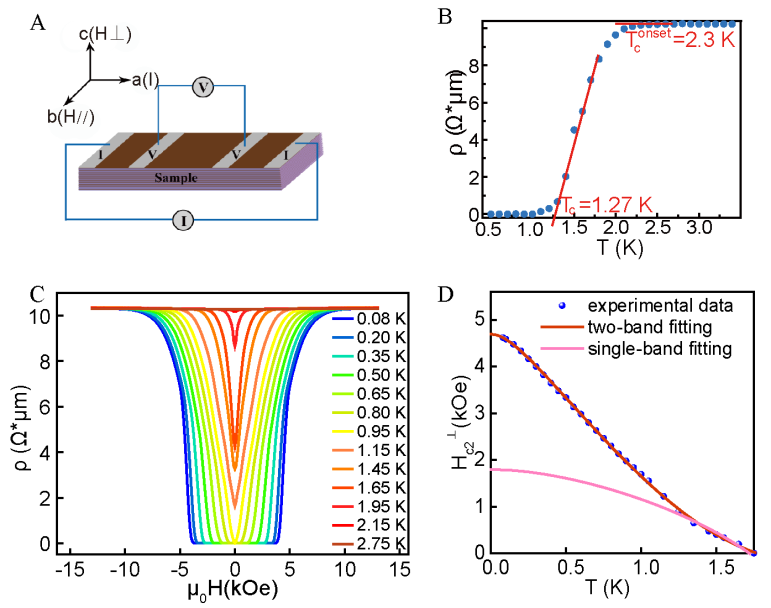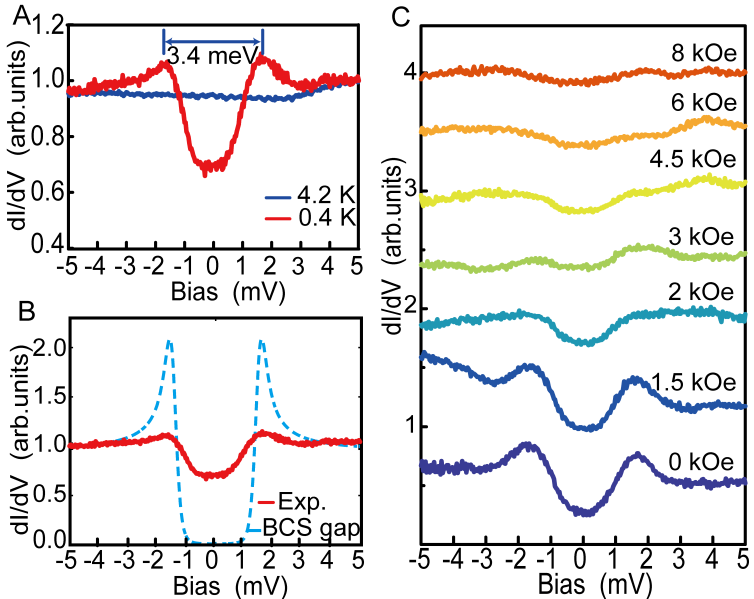PNAS reports Jian Wang group and collaborators’ work on the observation of non-trivial superconductivity in topological Weyl semimetal MoTe2-xSx crystals
2018-10-31
ecently, the exotic edge states in topological superconducting materials have drawn broad attention owing to their Majorana fermionic quasiparticles. A Majorana fermion is a particle that is its own antiparticleand displays unusual non-Abelian statistics. Majorana quasiparticle in condensed matter system with its exotic braiding property can be used to build fault-tolerant quantum computer. Prof. Jian Wang and collaborators detected non-trivial superconducting signatures in sulphur doped type-II topological Weyl semimetal MoTe2.ThisMoTe2-xSx (x~0.2)is also a layered transition metal dichalcogenide and thus has potential applications in future topological Weyl semimetal and superconductor nano-devices.
In 1929, physicist Hermann Weyl theoretically predicted that there is a kind of massless fermion whose spin is half-integer and can be described by Weyl equation. It is named as Weyl fermion but hasn’t been observed as a fundamental particle in nature yet. However, researchers recently realized that Weyl fermion can be realized as emergent quasiparticle in condensed matter system like in the electronic crystals. This series of electronic crystals are called topological Weyl semimetal. A Weyl semimetal is a crystal system whose low energy excitation has linear dispersion and can be effectively described by the Weyl equation. Weyl semimetals are also characterized by non-trivial topological invariants, broadeningthe classification of topological phases of condensed matter beyond topological insulator. The Weyl points (WPs) in Weyl semimetals with different chirality locate at different position in momentum space. And the WPs act like monopoles that are either a source or a sink of the Berry curvature. On the crystal boundary, novel metallic non-closed topological surface states (Fermi arcs) connect the projection of the WPs with opposite chirality. In contrast to relativistic fermions, the quasiparticle in the less constrained condensed matter systems doesn’t need to respect Lorentz invariance.
Topological materials that host superconductivity are ideal systems to detect topological superconductivity and Majorana fermions. The superconductivity of topological surface states in topological Weyl semimetals may offer a new opportunity to study topological superconductivity beyond the proximity effect induced superconducting surface states in topological insulators. Based on the paring symmetry of superconductor, there are s wave, p wave and dwave superconductors. And the strong interband coupling in s wave superconductor can result in the π shift (s+-pairing) between the order parameters on different superconducting bands, such as generally accepted Fe-bases superconductors. Moreover, this kind of sign change of the superconducting gap function between different Fermi surfaces in time reversal invariant topological Weyl semimetal can lead to topological superconductivity (Phys. Rev. B 90(4):045130).
Recently, Prof. Jian Wang, Prof. Ji Feng at Peking University and Prof. Tong Zhang at Fudan University, in collaboration with Prof. Shiyan Li at Fudan University, Prof. Yong Wang at Zhejiang University, Prof. Mingliang Tian and Dr. Langsheng Ling at Heifei High Magnetic Field Laboratory of the Chinese Academy of Sciences, Prof. Nitin Samarth at Pennsylvania State University demonstrated their observations of non-trivial superconducting signatures in topological MoTe2-xSx crystals. The samples are grown by chemical vapor transport method.
Firstly, theyobserved the quasiparticle interference patterns of Fermi arcs at the surface of MoTe2-xSx crystal, which are consistent with the calculated non-trivial band structure. Then, they detected a relatively large superconducting gap on the sample surface and the gap to critical temperature Tc ratio (Δ/kBTc) is 8.6. This value is much larger than that of the conventional weak-coupling superconductors, and also larger than the bulk superconducting gaps fitted from the specific heat measurement.The large superconducting gap they detected might be from superconductivity parity mixing or unconventional paring mechanism on the surface, potentially indicating the non-trivialsuperconductivity from Fermi arc surface states. Moreover, their transport and specific heat measurements show two-band superconductivity with potential s+- wave arising from a dominant interband coupling. Thus, the material could be the other s+- superconductor besides Fe-based superconductors. This s+- paring superconductivity also makes the Weyl semimetal material MoTe2-xSxa promising topological superconductor candidate, the corner stone for future topological quantum computation.The paper was published in PNAS on August 31, 2018. (DOI: 10.1073/pnas.1801650115) (Link:https://doi.org/10.1073/pnas.1801650115)
Prof. Jian Wang, Prof. Ji Feng at Peking University and Prof. Tong Zhang at Fudan University are corresponding authors of this paper. Yanan Li, Qiangqiang Gu at Peking University and Chen Chen at Fudan University contributed equally to this work.
This work was supported by the National Basic Research Program of China, the National Natural Science Foundation of China, and the Strategic Priority Research Program of Chinese Academy of Sciences etc.
Figure 1. Signature of s+- superconductivity in MoTe2-xSx. (A) Schematic structure for electrical transport measurements in MoTe2−xSx. (B) Typical resistivity–temperature curve of MoTe2−xSx showing superconductivity. (C) Magnetoresistance at various temperatures under perpendicular field. (D) Temperature dependence of Hc2⊥from the data in (C). The red curve is the best fit of two-band s-wave model to the experimental data. The fitting parameters showing strong interband coupling, indicates s+- superconductivity in MoTe2-xSx.
Figure 2.Large superconducting gap on the surface of MoTe2-xSx, which reveals the possibility of non-trivial superconductivity from topological surface states. (A) dI/dV spectrum taken on MoTe2-xSx sample. An anomalously large superconducting gap with Δ = 1.7 meV (as marked) was clearly observed at 0.4 K. (B) Comparison of the measured gap (red curve) with a simulated isotropic BCS gap (dashed curve). (C) dI/dV spectrum measured at 0.4 K under various magnetic fields. The superconducting gap is suppressed by increasing the magnetic field.

